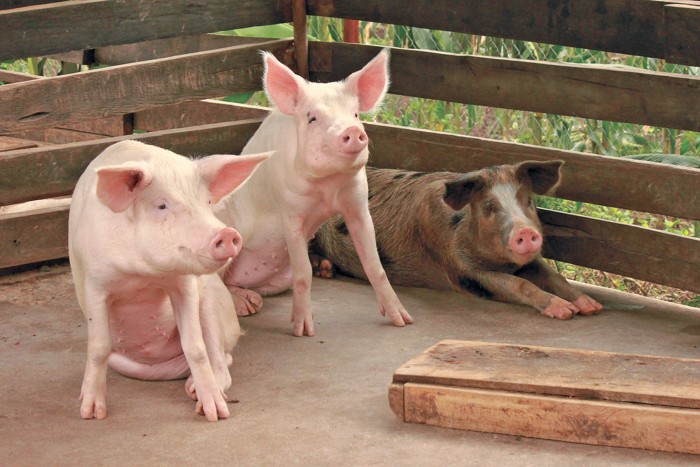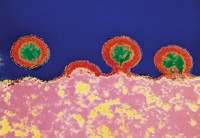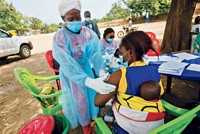Advertisement
Grab your lab coat. Let's get started
Welcome!
Welcome!
Create an account below to get 6 C&EN articles per month, receive newsletters and more - all free.
It seems this is your first time logging in online. Please enter the following information to continue.
As an ACS member you automatically get access to this site. All we need is few more details to create your reading experience.
Not you? Sign in with a different account.
Not you? Sign in with a different account.
ERROR 1
ERROR 1
ERROR 2
ERROR 2
ERROR 2
ERROR 2
ERROR 2
Password and Confirm password must match.
If you have an ACS member number, please enter it here so we can link this account to your membership. (optional)
ERROR 2
ACS values your privacy. By submitting your information, you are gaining access to C&EN and subscribing to our weekly newsletter. We use the information you provide to make your reading experience better, and we will never sell your data to third party members.
Vaccines
Can CRISPR help stop African Swine Fever?
Gene editing could create a successful vaccine to protect against the viral disease that has killed close to 2 million pigs globally since 2021
by Geoffrey Kamadi, special to C&EN
April 28, 2024
| A version of this story appeared in
Volume 102, Issue 13

Pig farmers have a problem. Since it was first detected in Kenya a century ago, African swine fever has spread to over 50 countries worldwide. In China, recent outbreaks have killed an estimated 40% of the country’s pig population. And since the viral disease has been found as near to the US as the Dominican Republic, potential contagion has also become a major concern for the pig industry in the US. The virus poses a big threat to the pork industry worldwide.
Though the disease has been around for a while, efforts to control its spread still rely on basic biocontrol methods such as culls. Combine that with the virulent nature of the disease and some farmers have begun to shy away from pig husbandry.
But the demand for meat products in Africa is on an upward trajectory. Pigs are considered relatively cost-effective animals to raise. They grow very fast and eat almost anything, which makes them suitable for raising in lower-income, rural settings.
The successful development of a vaccine for African swine fever would be welcome news for the pig industry on the continent. To try to solve this problem, researchers at the International Livestock Research Institute (ILRI), based in Nairobi, Kenya, have recently developed a novel vaccine candidate against the genotype IX strain of the African swine fever virus (ASFV) using a CRISPR-enabled gene deletion method.
By knocking out a key section of the viral genome, the researchers created a weakened form of the virus that can induce an immune response without becoming an infectious disease. Vaccines based on weakened versions of viruses are often referred to as attenuated virus vaccines.
“The CRISPR technology is quite easy to use, and therefore efficient, compared with traditional methods,” for searching for attenuated virus vaccines, says Lucilla Steinaa, a scientist at ILRI and a co–principal investigator behind the development of the vaccine candidate.
The researchers say the vaccine candidate exhibits a strong safety profile and 100% protection against the genotype IX strain of ASFV in controlled experiments. This development raises new hope for the successful containment, and possibly elimination, of the disease.
Before commencing work on the vaccine candidate, ILRI scientists had been conducting epidemiological studies on African swine fever for several years. The vaccine search began in 2016.


But the work to develop a vaccine against ASFV using gene knockouts has been challenging because the virus responsible for causing the disease “is a large DNA virus containing 160 genes,” Steinaa says. “It is much [more] difficult to work with such a virus compared with, say, an RNA virus with just 11 genes.”
In other words, there are a lot of genes to choose from before researchers can find the right genes to edit. In any case, “you need to have all the genetic sequences of the different strains of the disease before you can do anything. This takes some time,” Steinaa says.
The development of this new ASFV vaccine candidate was a collaborative effort involving ILRI, the J. Craig Venter Institute (JCVI), and Walter Fuchs and his team based at the Friedrich Loeffler Institute in Greifswald, Germany. The researchers’ focus was coming up with an effective vaccine to be used in East Africa against genotype IX of the disease. They aim to expand the approach and perhaps eventually deploy it worldwide. ILRI used the CRISPR method to knock out individual genes, while JCVI researchers used their synthetic biology expertise.
Sanjay Vashee, the co–principal investigator of the project at JCVI, explains that his lab used synthetic genomics to build whole genomes from the bottom up and to make combinatorial, genome-wide modifications to the ASFV.
On its own, the ASFV genome is not infectious, Vashee says. So the scientists developed a novel “boot-up” system to generate live virus from the assembled recombinant genomes, thereby coming up with the first reverse genetics systems for ASFV, specifically for the genotype IX strain.
By working together, the research teams built multiple modified viruses. “In combination, we generated over 30 different recombinant viruses that can be tested for attenuation and protection as vaccine candidates,” Vashee says.
After tests in the lab, ILRI researchers evaluated the candidate in animals for up to 4 weeks. The candidate will now be assessed for genetic stability. It will also need to be tested against regulatory requirements before it can be manufactured and put on the market.
One test that regulators require is known as the reverse vaccine candidate test, to gauge whether the disease can become virulent again after the vaccine has been administered multiple times in pigs. “However, this is relatively unlikely given that the gene [for virulence] has been deleted,” Steinaa says.
The scientists are also looking into whether cross-immunity action is possible, allowing the vaccine candidate to provide protection across the different genotypes of the virus.
The ILRI vaccine is based on genotype IX, which is the most prevalent strain of ASFV in the East African countries of Kenya, Uganda, and Tanzania. That strain has also been found in the Republic of the Congo. Another widely spread strain is genotype II, which circulates in Europe and Asia, whereas genotype I is mostly confined to West Africa, Portugal, Spain, and the Italian island of Sardinia. It is not known why a certain strain is more prevalent in a given geographical location.
In total there are 24 genotypes of ASFV, and all of them originated in Africa. But “there is a lot of work to be done to see whether we need to make 24 vaccines,” Steinaa says.
The further apart one strain of the disease is from another on the ASFV family tree , the less likely a vaccine developed for one branch will offer protection for the other. For instance, genotype I is much closer to genotype II than either is to genotype IX. So a vaccine developed for genotype I is more likely to offer some protection against genotype II, compared with its ability to protect against genotype IX.
“So far, our genotype IX vaccine candidate certainly protects against [genotype IX],” Vashee says. “However, we have not yet tested whether it can protect against other genotypes.”
But even if the vaccine protects against only one genotype, the scientists see the successful development of the genotype IX vaccine candidate as a possible blueprint for similar efforts against other strains. And vaccines for all strains are sorely needed.
Last year, a vaccine against the genotype II strain of ASFV—the one circulating in Asia and Europe—was approved by regulatory authorities in Vietnam. It was the first ASFV vaccine to be approved, but then it elicited safety concerns. Several pigs died following inoculation with the vaccine, and the World Organisation for Animal Health (WOAH)—a global authority on animal health—released a statement urging farmers to use only those ASFV vaccines that have been shown to be effective and safe.
One of the biggest challenges facing the successful deployment of the ILRI vaccine candidate, should it be approved for manufacture, lies in the potentially low demand for it. Unlike in Europe and Asia, the market for an ASFV vaccine in East Africa is quite small.
To start creating awareness of the vaccine candidate ahead of possible approval, the researchers are now starting to work in conjunction with relevant regulatory bodies. But these talks have only just begun, Steinaa says.
In the meantime, the researchers are writing a manuscript describing the reverse genetics system they developed during their search for an ASFV vaccine, including the boot-up method, Vashee says. Until publication, they’ll be keeping details close to their chests.
Geoffrey Kamadi is a freelance journalist based in Kenya.





Join the conversation
Contact the reporter
Submit a Letter to the Editor for publication
Engage with us on Twitter